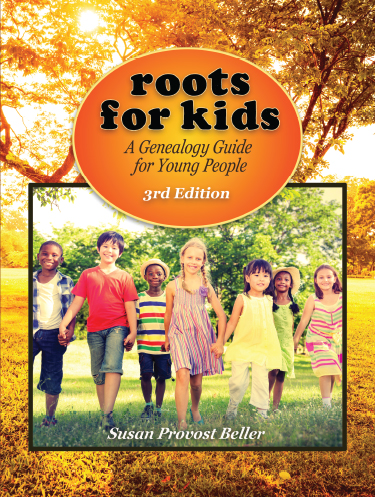
Roots for Kids. 3rd Edition Introduces Youngsters to Genealogy Databases
In the thirteen years since Genealogical.com published the 2nd edition of Susan Provost Beller’s classic book, Roots for Kids. A Genealogy Guide for Young People, the genealogical landscape has changed considerably. While the author emphasizes that kids should still begin their research by “exploring our own families, gathering documents and stories from them, she emphasizes that” the shift to actual records is much easier because of “the wealth of information that can now be accessed from the comfort of your own home.” To be sure, the methodology of sound genealogy—even for teens and pre-teens—has not changed, so the new Roots for Kids still has chapters on oral history questions, evaluating your information, and blank forms and charts for organizing information. On the other hand, when describing the records themselves, Mrs. Beller has added new chapters for Finding Local Records on the Internet, Finding State and National Records on the Internet, and Research Around the World on Your Computer.
To illustrate the new emphasis on online research in Roots for Kids. A Genealogy Guide for Young People. 3rd Edition, here is a sample selection describing just a few of the most important genealogy databases:
Ancestry
Ancestry.com (www.ancestry.com) is the largest of the subscription genealogical services, making more than 24 billion records available to its users. It can be fairly expensive to get for yourself at home, but you can often use it for free at your public library or at a Family History Center run by the members of The Church of Jesus Christ of Latter-day Saints. Searches for a name will often turn up thousands of results. Some will be in census records, others in vital records, directories, obituaries, land records, military records, family or local histories, or newspaper articles. If you are new to genealogy, this can be an overwhelming experience, and it sometimes can take a lot of time to get to information that pertains to the person you are researching. At the same time, by using the site’s passenger lists alone, I was able to solve the Murphy riddle, very much a version of finding a needle in a haystack! I would definitely check to see if your public library has subscribed to Ancestry.com but only get into this site once you have quite of bit of information already at hand.
Fold3
A part of the Ancestry.com family of websites, Fold3 (www.fold3.com) is an archive of military records. It can be accessed as part of a comprehensive membership in Ancestry, along with the site Newspapers. com that we spoke of in the local records research chapter. However, it can also be accessed as a stand-alone database. It does offer some free materials that you can search, and sometimes around Memorial Day and Veterans Day it will offer free searching for everyone for several days.
HeritageQuest Online
HeritageQuest Online (www.heritagequestonline.com), which is also affiliated with Ancestry, is another subscription genealogy site but has some slightly different records that you can search. In addition to containing census records, over 20,000 books, and an index of news articles, the site includes abstracts of the Revolutionary War pensions and the Freedman’s Bank documents. This site is only accessible at a subscribing library or institution—there are no individual subscribers—but library members can use the site for free.
MyHeritage
This is another subscription website (www.myheritage.com). It has about 8 billion records available, much fewer than Ancestry.com offers, but it costs less to access. It is affiliated with a different site called Geni (www.geni.com), which is a collection of family trees submitted by its users. Unlike many of the family trees posted on the internet, this site often includes proper documentation. That makes it a good way to find out how other researchers are matching family members and what proof they have for their decisions.




